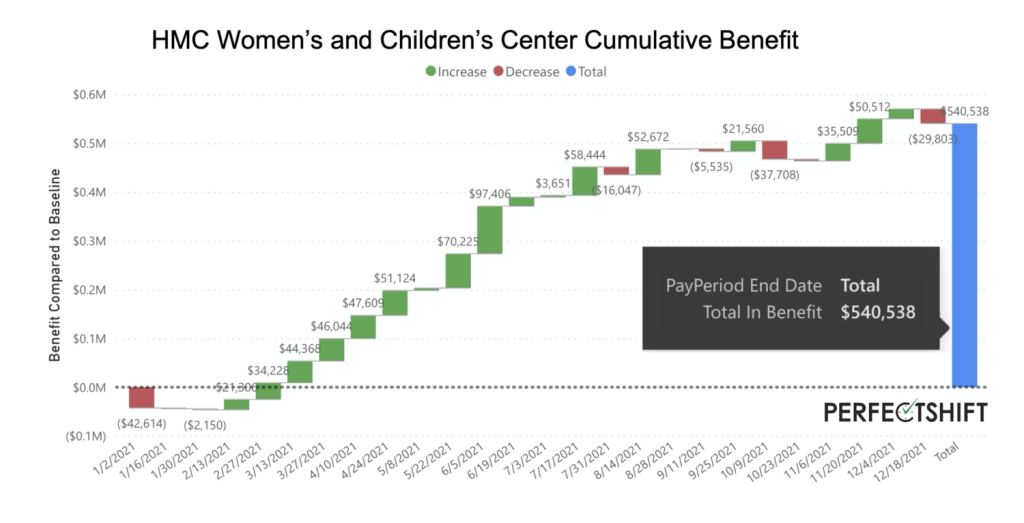GOAL
•Improve patient care, service, response. Reduce Costs. Eliminate diverting of patients
OUTCOMES
•A significant change in the tools and techniques for planning and assigning appropriate staff using real-time PERFECTSHIFT methodology, “…allowing us to reduce our costs, improve our ability to respond to census and acuity changes, and substantially reduce and eventually eliminate diverting patients. Also, we have achieved a happier team of caregivers.”

•Census increased by 26% due to new staffing processes.
•The ability to accommodate an increase in census of over 25% due to improved management processes.
•More than $500,000 of annual cost improvements achieved within the first year of implementation.
OHSU Hillsboro Medical Center leaders identified a need to improve costs along with safe and predictable staffing throughout the hospital. Through their work with PERFECTSHIFT, they succeeded in optimizing labor productivity, while ensuring the organization could provide optimum service and care. Empowering the front-line managers with the PERFECTSHIFT Suite of Tools, along with an appropriate level of coaching and troubleshooting throughout the organization, helped to empower the staff and enhance the patient experience while reducing costs. Hillsboro CNO Jennifer Packer, MSN, RN, CENP, CEN, collaborated with PERFECTSHIFT to overhaul an outdated staffing model and include employees in meeting targeted financial goals. This collaborative process created a successful environment to tackle the issues that many similar organizations face – and create fairly remarkable success.
For instance, during house-wide implementation of the PERFECTSHIFT Platform of Tools, the Women’s and Children’s Center (WCC) decided to focus on departmental labor productivity as a Quality Improvement project. They needed better staffing control to include daily productivity tools to determine the required staffing needed and the tangible ability to manage resources in real time. WCC leaders worked together with PERFECTSHIFT implementation advisors to adjust the platform to address their unique needs.
BACKGROUND
Hillsboro Medical Center is an important partner in the OHSU Health continuum of care. OHSU, as the only Academic Medical Center in Oregon, has an important mission in the greater Oregon community, and their ability to care for their patients across a wider area is critical. As such, it was expected that Hillsboro be able to successfully accommodate the widely variable ongoing fluctuations in patient acuity and census by meeting the associated care delivery parameters of their partnership. Within the WCC, long-established staffing patterns weren’t accommodating the complexity of even greater fluctuations and imbalances. The existing staffing models and techniques, like most we see, were unable to provide real-time information on how acuity, rapid census change and other factors were causing critical service issues within the Center. Retrospective data was of no use. The WCC was suffering and even diverting patients at times when their conditions became untenable.
“It was a real challenge to discover our true minimum staffing. I didn’t have what I needed to move from ineffective and inefficient processes to new ways to see data in real time.
— Lindsey Kennedy, MSN, RN – WCC Manager
NEW PROCESSES
Along with WCC Director Patty Poe, MSN, RN, Kennedy collaborated with PERFECTSHIFT to implement its Management Planning and Control System, including weighted average acuity values promoted by the Association of Women’s Health, Obstetric and Neonatal Nurses (AWHONN). This presented variances in terms of RNs instead of hours, leading to a high level of inter-rater reliability. The single management system yields two performance measures: 1. Budgetary/financial and 2. Operational. Kennedy observed both measures lead to operational excellence and sustainability.
The Charge Nurses in the WCC took “charge” in the implementation of the PERFECTSHIFT Platform of Tools. Each were educated on the suite, then entered staffing, patient acuity and volume data on a 4-hour periodic basis. The data allowed them to thoughtfully look at their staffing decisions in real time and give them predictive capabilities in the short term. Kennedy noted she felt like she was “micromanaging” at the beginning, but as charge nurses and staff became more comfortable with the process, she was able to focus more on keeping the workplace safe, consistent, and stable while the charge nurses focused on maintaining appropriate staffing. Charge nurses and department managers necessarily have important care decisions in their routine, but when you involve them in proactive planning of staffing for their patients, the service, care and morale within the department can improve while costs go down.
“Labor and Delivery has very dynamic changes hour to hour,” Kennedy said. “PERFECTSHIFT’s platform allows us to be more fluid. We can align our staff with patient volume and meet our budgetary targets while maintaining excellent patient care. PERFECTSHIFT gives me actionable data that marries all our realities on the WCC – our charge nurses can be proactive in staffing, which they and our staff appreciate.”
OUTCOMES
Kennedy and Poe point to several positive outcomes from their collaboration with PERFECTSHIFT. The first is financial, but, perhaps more significant is the change in culture OHSU Hillsboro has experienced through implementation of the platform.
“We implemented this platform before COVID became an issue. When it hit, with multiple staff shortages and an expected surge in patients, we were able to stay on target by using the PERFECTSHIFT Platform of Tools.
— Patty Poe, MSN, RN – WCC Director, OHSU Hillsboro
Using PERFECTSHIFT, Kennedy notes her department has been on target the majority of 2021. By the end of the year, she was able to save her organization more than $500,000 annually through staffing efficiencies while maintaining staff satisfaction.
“We focused on PERFECTSHIFT as a tool to help us stop and think about what’s going on, what will go on and what’s truly needed,” she said. “We’re working hard to get to flexible workforce staffing in the moment. I didn’t have to compromise ratios to provide the highest quality of care. At the same time, I don’t have to call staff on or off because I don’t know what our needs will be. Patients and staff are happy and satisfied, and we’re exceeding our budgetary targets.”
